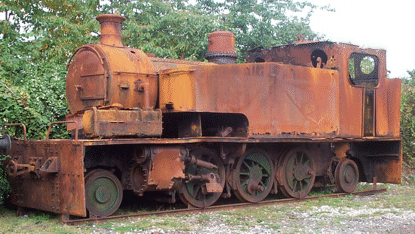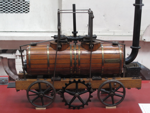 As part of a successful Heritage Lottery Fund bid, the Middleton Railway has embarked on a project to conserve Picton (Hunslet 1540 of 1927), illustrated below. This locomotive forms an important part of the Leeds locomotive building story and our history, having been built less than a mile from the railway. It was part of a range of standard locomotives that was developed by Hunslet’s specifically for export, which differed from the range of 0-6-0 saddle tanks that they built of industrial use in the UK (such as Brookes No. 1, whose overhaul is also funded by the same lottery bid) by having outside cylinders and side tanks. They also had a variety of wheel arrangements (Picton is a 2-6-2), and were built for a variety of gauges (although Picton is for standard gauge track, but it is significantly wider than a standard gauge locomotive for UK use would be).
As part of a successful Heritage Lottery Fund bid, the Middleton Railway has embarked on a project to conserve Picton (Hunslet 1540 of 1927), illustrated below. This locomotive forms an important part of the Leeds locomotive building story and our history, having been built less than a mile from the railway. It was part of a range of standard locomotives that was developed by Hunslet’s specifically for export, which differed from the range of 0-6-0 saddle tanks that they built of industrial use in the UK (such as Brookes No. 1, whose overhaul is also funded by the same lottery bid) by having outside cylinders and side tanks. They also had a variety of wheel arrangements (Picton is a 2-6-2), and were built for a variety of gauges (although Picton is for standard gauge track, but it is significantly wider than a standard gauge locomotive for UK use would be).
As such, Picton is a rare example, because there are very few representatives of this range of locomotives left in this country, precisely because nearly all of them were exported. It was one of a batch of three built for export to a sugar mill in Trinidad, where it spent the whole of its working life. It was discovered there by David Monckton, a former chairman of the Middleton Railway Trust, along with the other two from the same batch. He recognised its importance as a representative of this range of exported locomotives, and he was eventually able to select it as the best of the three survivors, re-import it back into the UK, and bring it to the Middleton Railway.
The picture below shows Picton when it first arrived at the Middleton Railway, with its wheels still attached to the lengths of rail on which it had been mounted for transport (it came from Trinidad as deck cargo on a banana boat). Still clearly visible on the wheels are the remains of the Brunswick Green paint that was the standard Hunslet colour scheme for locomotives where the new owners did not specify that their own livery was to be used.

When Picton first arrived at the Middleton Railway there were some suggestions that it should be restored to working order, but these did not last long once it was realised that the locomotive's bufferbeams are so wide that they would demolish the railway's platforms. Also, once the locomotive was inspected carefully it quickly became apparent that so much of it would have to be replaced that this would be more a matter of building a replica than restoring the original. Indeed, this inspection revealed that the tanks and cab were so badly corroded that they were actually dangerous, and they had to be taken off the locomotive.
Thus, when the Middleton Railway set up its project to acquire Brookes No. 1 and Picton from David Monckton and then conserve them, the most that could realistically be done for Picton was firstly to coat it with preservative (having prepared the surface of the metal by shotblasting it), and then to construct a building to protect it from the elements. The construction of this "Picton Shelter" building is thus a major part of this conservation work, and separate pages give more detail of the construction of this shelter.
Go on to the next stage in this project.
More Information
Pages about other projects:
- Last Coals to Leeds;
- Raising Steam in No. 6;
- Project Phoenix;
- Building a Running Shed;
- Overhauling "Brookes No. 1".
Other pages provide more information about:
- Our portfolio of development projects;
- Our museum collection;
- How you could get involved;
- What we offer for visitors;
- Our train services;
- How to find us.







